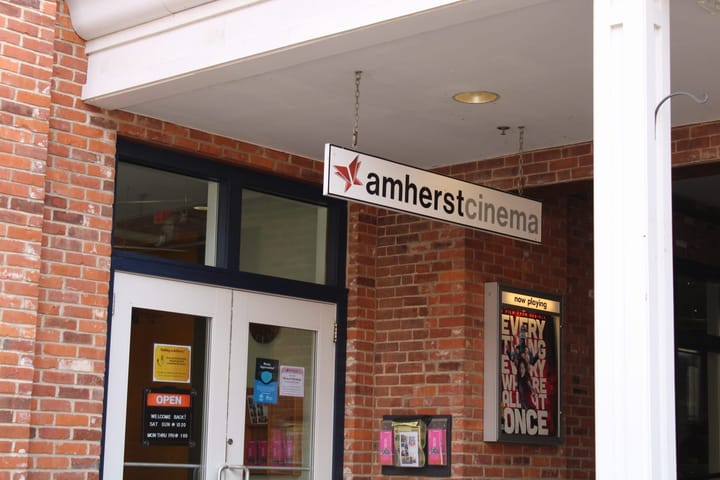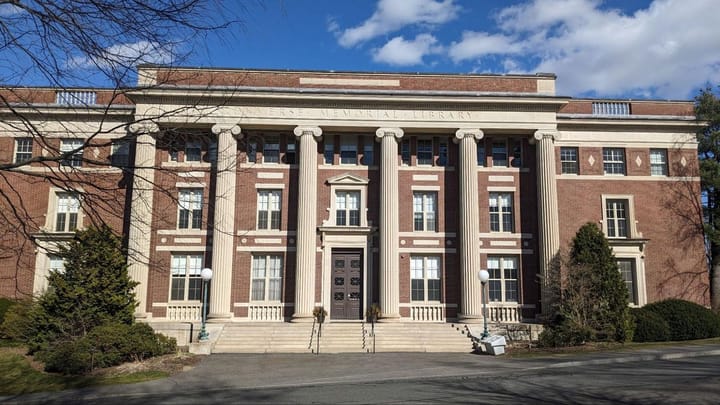Harlem Renaissance Mixes History, Performance
A hush fell over the audience as all eyes turned towards the stage. Jonathan Mosley ’01 and Bonett, the event’s two hosts, smiled back at the crowd. One would not have thought it possible that only two hours before, the area had been filled with sweatpants-clad college students wolfing down dinner.
Now, many of the same students were wearing evening dresses and suits. Each formerly bare table was draped with a white cloth and decorated with flowers and a single long candle. Thanks to careful planning by Amherst’s Black Student Union, the transformation was complete.
“I really liked the formal atmosphere,” said Kim Kwei ’04. This environment was important to many other members of the audience as well.
“My favorite part was being there with so many people and being in a social environment that had nothing to do with school. As the Harlem Renaissance [ad] said, ‘An Evening of Elegance,'” said Area Coordinator Joel Estrada ’00.
The night began with Bonett’s explanation of the Harlem Renaissance as a historical event, reading from the program that had been distributed at the entrance: “The Harlem Renaissance was an African American cultural movement of the 1920s and early 1930s that was centered in the Harlem neighborhood of New York City.”
During this period, African-American literature, art, music, dance and social commentary began to flourish in Harlem. The movement redefined African-American expression and transformed American culture in general.
For Bonnett, having this background was essential to fully appreciating the event. “I liked having the history explained,” she said. “This is the first year that we’ve done that.”
Performers in particular appreciated the reading of the history because the Harlem Renaissance had informed their art. “The things I’ve learned artistically stem from the Harlem Renaissance,” said Terell Cooper ’02, who sang Zhane’s “For a Reason” with Shanina Robinson ’02.
After Bonett finished explaining the historical background, the night’s performances began. Travis Bristol ’03 started the evening with his rendition of “Lift Every Voice and Sing” by James Weldon-Johnson.
He was followed by a special number by Return to the Source, a band started by Junius Williams ’65. The nine-member band included musicians who had played with such music geniuses as Duke Ellington.
The band played many old jazz tunes, including “Take the A-train,” while giving a slide show that depicted the atmosphere and people of the Harlem Renaissance.
Although students praised Return to the Source’s talent, they also said they appreciated the group for reasons other than their musical genius. “Usually it becomes a talent show, but Return to the Source was about the actual Renaissance itself,” said Andrew Unger ’03.
This was a large part of the BSU’s goal in inviting Return to the Source to perform. “In the past, our Renaissance celebration has been more of a showcasing of the talent within the community,” explained BSU chair Marlon Cush ’02. “However, this year I wanted the audience to leave with a greater knowledge of what the Harlem Renaissance period.”
The rest of the night was dedicated to Amherst student musicians, actors and poets who performed short pieces. Cush explained that this portion of the show was “intended to show how the energies of the Renaissance period are still alive within Amherst’s talented students.”
The first presentation was a dance choreographed by Tene Howard ’01 to the song “Two for Blue,” by Charlie Hunter. David Holland ’02 and Guy A. Johnson ’99 followed with poetry readings and John Orraca-Tetteh ’02 and James Orraca-Tetteh ’02 showed off their gifts for composing music with both instrumental and a cappella pieces.
The night even included a short play directed by Amber Stroud ’02E. The piece, entitled “The Last of Mama on the Couch,” starred several Amherst students, including Teri Harris ’01, Lais Washington ’01 and Claudia Gunter ’04.
This act was followed by a guitar solo by Reginald Jackson ’01, performing “Lenny” by Stevie Ray Vaughn. Later came a dance presentation choreographed by Renata Robinson ’04. The night ended with a rap performance by Garrick Perry ’02E, James Reed ’01 and Unger.
The entire performance stretched beyond its targeted two hours, but the audience didn’t seem to mind. “There was a lot of talent there-I was really impressed,” said Kwei. “The poetry and the piano piece were excellent.”
Patty Chang ’01 added, “It’s amazing every year. The people themselves are amazing performers, dancers and actors.”
Even those who participated were pleasantly surprised by the event. “I had seen everyone practicing, but I was really impressed how things came together,” said Jackson.
In addition to being entertained, the audience left the event with a fuller understanding of the historical significance and cultural atmosphere of the Harlem Renaissance. “I loved how it was a celebration and affirmation of Black culture,” said Chang.





Comments ()